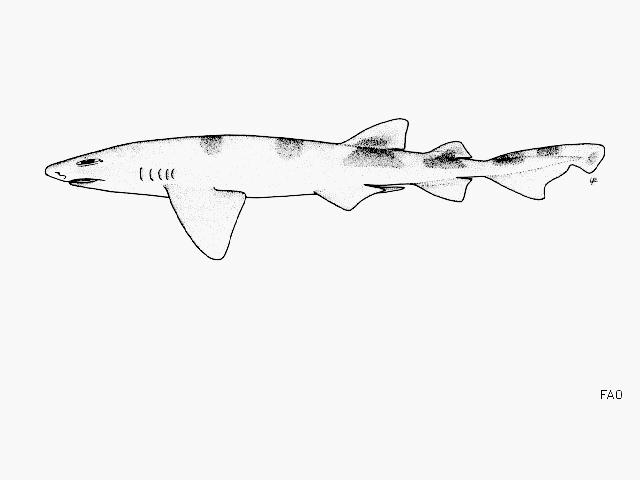Cephaloscyllium sufflans
(Regan, 1921)
Balloon shark
Classification: Elasmobranchii Carcharhiniformes Scyliorhinidae
Reference of the original description
New fishes from deep water off the coast of Natal. Annals and Magazine of Natural History, (Series 9), 7(41), 412–420
New fishes from deep water off the coast of Natal. Annals and Magazine of Natural History, (Series 9), 7(41), 412–420
Image of the original description
No image in first description.
No image in first description.
Synonyms / new combinations and misspellings
Scyliorhinus (Cephaloscyllium) sufflans, Scylliorhinus sufflans
Scyliorhinus (Cephaloscyllium) sufflans, Scylliorhinus sufflans
Description :
Citation: Cephaloscyllium sufflans (Regan, 1921): In: Database of modern sharks, rays and chimaeras, www.shark-references.com, World Wide Web electronic publication, Version 01/2026
Please send your images of "Cephaloscyllium sufflans" to info@shark-references.com

Cephaloscyllium sufflans (Regan, 1921), © FAO, www.fish-base.org

Cephaloscyllium sufflans (Regan, 1921), © FAO, www.fish-base.org
Common names
 Pejegato balón,
Pejegato balón,  Holbiche soufflue,
Holbiche soufflue,  Balloon shark,
Balloon shark,  Swell shark,
Swell shark,  Pata-roxa ensuflada
Pata-roxa ensuflada
 Pejegato balón,
Pejegato balón,  Holbiche soufflue,
Holbiche soufflue,  Balloon shark,
Balloon shark,  Swell shark,
Swell shark,  Pata-roxa ensuflada
Pata-roxa ensuflada
Short Description
Original diagnosis after Compagno, 1984 [517]: Snout broadly rounded-angular in dorsoventral view, broad and short; anterior nasal flaps fairly elongate and lobate, not overlapping mouth posteriorly. Claspers moderately short and stout. Colour pattern of 7 light grey-brown saddles on a lighter, pale-grey brown background, these underside of head saddles obscure or absent in adults, pectorals dusky above, underside unspotted; fins without conspicuous light margins. A large species.
Original diagnosis after Compagno, 1984 [517]: Snout broadly rounded-angular in dorsoventral view, broad and short; anterior nasal flaps fairly elongate and lobate, not overlapping mouth posteriorly. Claspers moderately short and stout. Colour pattern of 7 light grey-brown saddles on a lighter, pale-grey brown background, these underside of head saddles obscure or absent in adults, pectorals dusky above, underside unspotted; fins without conspicuous light margins. A large species.
Distribution
Western Indian Ocean: Mozambique and Natal, South Africa [517]. Records from the Gulf of Aden are doubtful. Nominal records from Viet Nam were based on an undescribed species often called Cephaloscyllium umbratile which was not even that species. Source: www.gbif.org
Western Indian Ocean: Mozambique and Natal, South Africa [517]. Records from the Gulf of Aden are doubtful. Nominal records from Viet Nam were based on an undescribed species often called Cephaloscyllium umbratile which was not even that species. Source: www.gbif.org
Human uses
fisheries: of no interest
fisheries: of no interest
Biology
Oviparous, laying one egg-case per oviduct [517]. Embryos feed solely on yolk [733]. Found on the continental shelf and upper slope, preferring areas with sand and mud bottoms [536]. Feeds on benthic animals, mainly crustaceans and cephalopods, but also bony fishes, and other elasmobranches [517].
Oviparous, laying one egg-case per oviduct [517]. Embryos feed solely on yolk [733]. Found on the continental shelf and upper slope, preferring areas with sand and mud bottoms [536]. Feeds on benthic animals, mainly crustaceans and cephalopods, but also bony fishes, and other elasmobranches [517].
Remarks
shark-references Species-ID=1316;
shark-references Species-ID=1316;
















